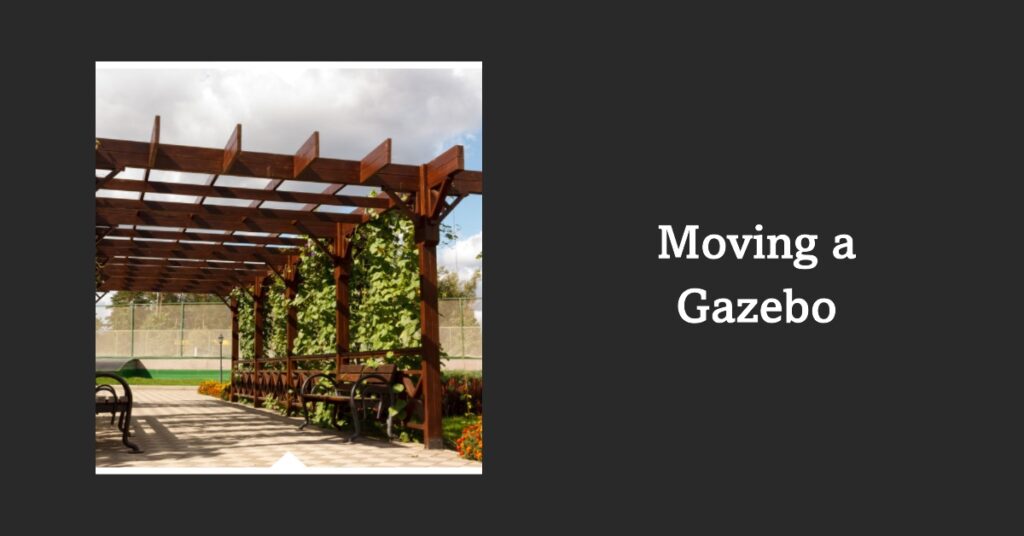Moving a gazebo can be an overwhelming task, especially considering its size and weight. However, with the right tools, techniques, and a well-thought-out plan in place, it is possible to safely transport your outdoor sanctuary to a new location. If you can’t do it yourself, you can call professional moving companies to help you out.
In this blog post, we will guide you through the entire process of relocating your gazebo step-by-step – from preparation to reassembly.
Preparing To Move A Gazebo
Assess the weight and size of the gazebo, gather the necessary tools and equipment such as hydraulic jacks, dollies, and heavy-duty straps, and clear the area around the gazebo of any obstacles before attempting to move it.
Assessing The Weight And Size Of The Gazebo
Before attempting to move your gazebo, it’s crucial to assess its weight and size. Accurate measurement of the dimensions and understanding of its overall mass will help you determine the necessary tools, equipment, and manpower needed for a successful relocation.
Start by measuring the length, width, and height of your gazebo using a tape measure or laser rangefinder.
Anecdotal evidence suggests that lifting an 8×12 storage building can be accomplished with 4-inch PVC pipes and a car jack; however, if you’re unsure about handling such heavy items yourself or have any concerns regarding safety issues during relocation (e.g., HOA restrictions), consider reaching out to professional outdoor structure movers who specialize in transporting gazebos like Yardistry models or 4 post pergolas.
Gathering Necessary Tools And Equipment
Before moving a gazebo, it’s important to gather all the necessary tools and equipment. This will help ensure a smooth and efficient relocation process. Some of the essential tools you may need include screwdrivers, wrenches, hammers, pliers, saws, and drills.
In addition to these basic tools, you’ll need specialized equipment like hydraulic jacks or dollies for maneuvering bulky outdoor accessories such as gazebos. You might also want to rent a trailer that is big enough to fit all parts of the gazebo safely during transport.
Lastly, don’t forget about safety gear such as gloves and eye protection when disassembling and reassembling the gazebo.
Clearing The Area Around The Gazebo
Before moving a gazebo, it’s important to make sure the area around it is clear of any obstacles that could get in the way. This means removing any furniture, plants, or other items that might be in the way of the move.
It’s also important to check for any uneven terrain or potential hazards like loose rocks or tree roots.
In addition, before starting the move, it’s a good idea to check with your HOA or local regulations about where you can move outdoor structures like gazebos. Some areas may have restrictions on where these types of structures can be placed within your property boundaries.
By checking ahead of time and adhering to local regulations, you can avoid potentially costly fines down the line.
Steps To Move A Gazebo
To move a gazebo, begin by disassembling it carefully, labeling and organizing all parts to make reassembly easier; then securely tie down each piece to prevent damage during transport.
Use proper lifting techniques and seek assistance from others when needed to avoid injury. To move the parts safely, use heavy-duty dollies or hydraulic jacks with wheels, which will facilitate smoother transportation of large pieces like roof panels or support beams.
Disassembling The Gazebo
Before moving a gazebo, it is important to disassemble it properly. This involves removing all the parts including the roof, walls, and flooring. A good tip before starting disassembly is to label and organize each part for ease of reassembly later on.
Start by removing any screws or nails that hold the structure together while keeping track of where each piece goes. Then remove any roofing material followed by wall panels if any are attached.
Finally, take apart the flooring carefully making sure not to damage or break any pieces in the process.
Securing The Gazebo For Transport
Before moving the gazebo, it’s important to secure all of its parts to ensure a safe transport. Begin by removing any loose items such as cushions or decorative objects and storing them safely away.
To prevent damage during transport, secure each container using bungee cords or rope. If you’re transporting the gazebo on a trailer or truck bed, use straps to secure it in place and prevent any movement while driving.
It’s always recommended that you seek assistance when moving larger outdoor structures like gazebos, especially if you’re not familiar with proper lifting techniques.
Hiring professional movers who specialize in relocating heavy outdoor structures can also be a wise investment for those who want peace of mind knowing their gazebo will arrive at its new location intact.
Moving The Gazebo To Its New Location
Once the gazebo is disassembled and secured for transport, it’s time to move it to its new location. The key here is to lift the gazebo from its center so that the weight is distributed evenly.
This will prevent any damage or distortion of the structure during transport.
For larger gazebos, hydraulic jack rental may be necessary. By using this equipment, heavy outdoor structures such as gazebos can be lifted off the ground and transported on a heavy-duty trailer.
However, without proper training and safety precautions, using hydraulic jacks can be dangerous.
Keep in mind that HOA restrictions may apply when relocating an outdoor structure like a gazebo. Ensure that all requirements are met before moving forward with your plan.
Finally, if hiring professional movers proves too expensive for your budget, there are other tried-and-tested ways to relocate a gazebo by oneself safely and effectively.
Techniques include rolling PVC pipes under each end of the disassembled roof trusses at least 10 feet apart between both sides while resting on a car jack.
Then place concrete blocks under each pipe until reaching near one end where half of them can then be picked up by two people while others hold onto their respective ends. This will distribute the weight evenly across different arms-wood parts along their lengths easing portability around obstacles if required!
Reassembling The Gazebo
Once the gazebo has been moved to its new location, it’s time to reassemble it. Begin by carefully unpacking all of the disassembled parts and checking for any damage that may have occurred during transport.
Start with the base of the gazebo and work your way up, attaching each section piece by piece until you’ve completed all sections.
As you reassemble your gazebo, keep in mind that some parts may need adjustments due to changes in ground level or weather conditions.
If all this seems overwhelming, consider hiring professional movers who are skilled at moving outdoor structures like gazebos.
Safety Precautions To Consider
Always prioritize safety when moving a gazebo. Use proper lifting techniques, wear protective gear, seek assistance when needed and be aware of the weather conditions.
Use Proper Lifting Techniques
Lifting heavy objects like gazebos can be quite challenging, but there are proper techniques to ensure that you don’t injure yourself in the process. When lifting a gazebo or any heavy object, it’s important to lift with your legs instead of just bending over and using your back muscles.
Additionally, it’s crucial to use teamwork when moving large outdoor structures. Have one person guide the others during the lifting process and communicate effectively to avoid accidents or mishaps.
Be sure also to wear protective gear such as gloves and sturdy shoes for added safety.
Wear Protective Gear
It’s crucial to wear protective gear when moving a gazebo or any heavy outdoor structure. Protecting yourself from injury should always be a top priority. Heavy-duty work gloves can help prevent blisters, cuts, and calluses while providing extra grip for lifting heavy parts of the gazebo.
Wearing sturdy safety boots with steel toes provides protection for your feet against dropped tools or other falling objects during disassembly and reassembly. A hard hat will protect your head from bumps and scrapes due to low-hanging branches or other obstacles that may come in the way while transporting the gazebo.
Don’t forget also to put on safety glasses as flying debris can cause serious eye injuries.
Moving a gazebo safely requires careful planning and attention to detail; investing in protective gear ensures both you and your helpers remain safe during every step of relocation.
Seek Assistance When Needed
Moving a gazebo is not something you should do alone. It’s always best to have a team of friends or family help with lifting and moving the structure. If possible, it’s also worth considering hiring professional movers who specialize in relocating outdoor structures.
It’s important to remember that safety should always be your top priority when moving heavy objects like gazebos. Back injuries and other accidents are preventable if proper lifting techniques are used, protective gear is worn, and assistance is sought when needed.
Check Weather Conditions
Before moving a gazebo, it’s important to check the weather conditions. Rain or snow can make the ground slippery and increase the risk of injury during the move. Strong winds can also create additional challenges when trying to maneuver a large structure.
It’s also essential to check any forecasts for changes in temperature, as sudden drops or spikes could cause damage or affect how well materials used in assembling your gazebo hold up.
Tips For A Successful Move
Label and organize all parts of the gazebo to make reassembly easier. Have a team of helpers to assist with lifting and maneuvering the structure. Take photos of the original location before disassembling for reference during reassembly.
Label And Organize All Parts
Before disassembling your gazebo, make sure to label all parts with markers or stickers. This will help you easily identify and match the corresponding pieces when it’s time to reassemble the gazebo in its new location.
Consider taking photos of each step while taking apart the gazebo. This way, you can refer back to them for guidance as needed.
By labeling and organizing all parts of your gazebo prior to moving day, you’ll be able to efficiently pack up the structure and have an easy time setting it up again at its new home.
Have A Team To Help
Moving a gazebo can be a daunting task, especially if it’s a large and heavy one. Having a team to help you with the move is crucial in making the process smoother and safer.
Not only does having a team make moving easier, but it also adds another layer of safety to prevent accidents or injuries. Remember always to use proper lifting techniques when handling heavy objects like gazebos, so as not to hurt yourself or others.
Additionally, having more hands allows you to disassemble and reassemble parts of the gazebo simultaneously, shortening your downtime between transport from old location to new location.
Moving outdoor structures has been made less stressful by professional movers who are available near your area; they provide expert labor services specializing in loading/unloading containers with bulky items such as gazebos without causing damage on fixture nor injuring anyone around them.
Take Photos Of The Original Location
Before disassembling your gazebo, take photos of its current location. This will serve as a reference for when you need to reassemble it in its new spot.
For instance, if there are tree branches or power lines nearby, you’ll need to be careful when lifting and moving the structure so as not to cause damage.
Remember that relocating a gazebo requires planning and attention to detail.
Consider Hiring Professional Movers
If you’re not comfortable moving a gazebo on your own, there’s no shame in seeking the help of professional movers. In fact, if your gazebo is particularly large or heavy, hiring experts may be necessary to ensure that it’s moved safely and with minimal damage.
Professional gazebo movers have all the equipment needed for safe and secure transportation, including hydraulic jacks and specialized trailers. They also have experience maneuvering bulky outdoor accessories through tight spaces without damaging surrounding landscaping or property.
It’s important to research local companies specializing in relocating outdoor structures such as gazebos before hiring anyone. Be sure to read reviews and ask for references from previous clients.
Conclusion
Moving a gazebo can be a daunting task, but with the right tools and techniques, it’s doable. Whether you decide to hire professional movers or tackle the project on your own, remember to take safety precautions and carefully disassemble and reassemble the structure.
Labeling parts, taking photos of the original location, and seeking assistance from friends or neighbors are all helpful tips for a successful move. Don’t forget about checking HOA restrictions and potential obstacles on your property before beginning the process.
Related Posts
How to keep birds out of my gazebo
Can you put solar panels on a gazebo
What’s the difference between a gazebo and a pavilion
Where to put a gazebo in the backyard
How to keep a gazebo from blowing away
How to hang lights in a gazebo
How to hang gazebo curtains
How to screen a gazebo
How to level a gazebo on sloped concrete
What to do with an old metal gazebo frame
Do you need a permit for a gazebo
How to build a gazebo on a deck
How to anchor a gazebo without drilling
How to decorate a gazebo for a wedding
How much does a gazebo cost
How to build a gazebo roof
What is a gazebo used for
What is the difference between a gazebo and pergola







